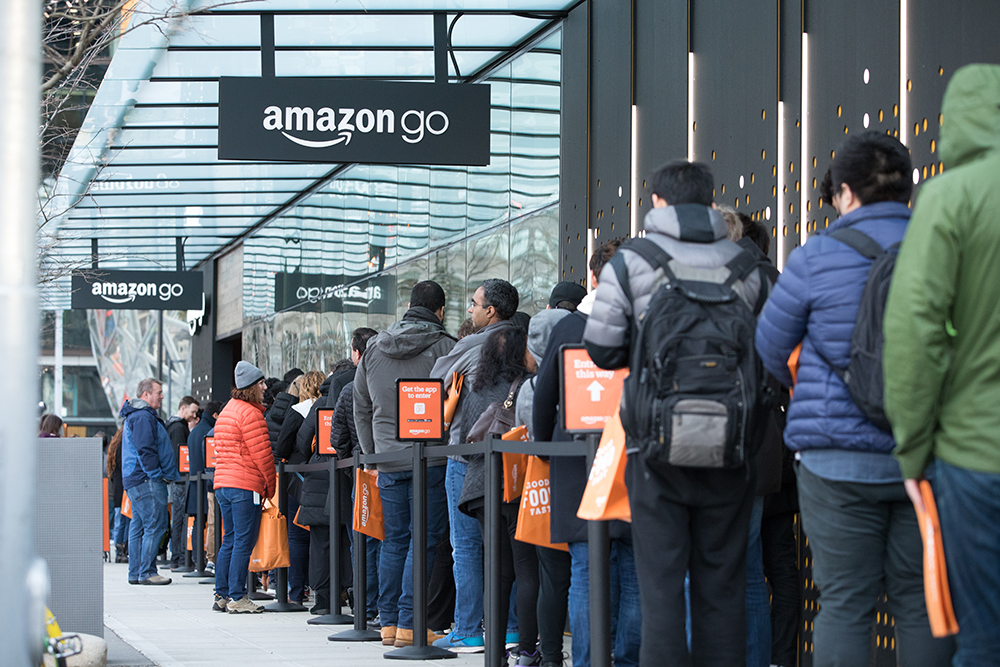No cashier, no lines – Amazon Go opens in Seattle

After months of testing and trials, retail behemoth Amazon has officially opened its flagship store in Seattle, launching a cashier-free, tech-savvy convenience shop known as Amazon Go.
With “no lines, no checkouts” and “the world’s most advanced technology” the store showcases a possible future for the retail industry where consumers enter, grab their items and go.
Here’s how Amazon Go works and why it’s attracting so much attention.
What is Amazon Go?
In simple terms Amazon Go is a convenience store offering consumers access to freshly-made food and groceries. But it’s the technology driving it that has the retail world watching with bated breath.
Rather than using traditional checkouts, consumers download the Amazon Go app to their smart phone. They scan the app at entry and simply wander the store selecting the items they need.
There is no checkout and no physical exchange of currency. The store senses what’s in a consumer’s basket and debits their Amazon account.
Or as Amazon explains:
“Our checkout-free shopping experience is made possible by the same types of technologies used in self-driving cars: computer vision, sensor fusion, and deep learning.
“Our Just Walk Out Technology automatically detects when products are taken from or returned to the shelves and keeps track of them in a virtual cart. When you’re done shopping, you can just leave the store. Shortly after, we’ll send you a receipt and charge your Amazon account.”
A long road to grab and go
Amazon first announced their concept store in 2016, having asked themselves: “what if we could create a shopping experience with no lines and no checkout?
“Could we push the boundaries of computer vision and machine learning to create a store where customers could simply take what they want and go? Our answer to those questions is Amazon Go and Just Walk Out Shopping”.
The store was initially tipped to open in 2017 but underwent a lengthy period of beta testing and trials by Amazon employees to ensure the technology was just right.
The tech behind it
Behind the cashierless store is a wealth of technology including cameras, sensors, and deep learning, and Amazon likens it to the technology utilised in driverless cars.
Initially it was expected Amazon would employ RFID to assist in product recognition, but although Amazon is not revealing the intricacies of how the technology works, they have indicated RFID is not playing a role.
Instead, a combination of images, weight sensors, and input data identifies products and determines when they’re removed from the shelf, adding items to a virtual cart as the consumer shops in the store.
If a shopper changes their mind, they simply place the item back on the shelf and it’s removed from their virtual cart.
The experience relies on the Amazon Go app, which shoppers download prior to entry. As they enter the store, they scan the app’s QR code and can then put their phone away. At the end, shoppers walk through a “transition area” that tallies up the value of items in their virtual cart. Their Amazon account is debited, and the receipt is sent to the app.
The way of the future?
There has been much hype that Amazon Go’s cashierless store represents the future of retail, but early indicators reveal this may not be the case any time soon.
The Go store is only 167 square metres and utilises an extensive and expensive array of technology to replace the good old cashier.
For larger retailers, this would prove cost-prohibitive, as The Inc explains:
“…the investment in cameras and sensors over a large space would be too huge, and the efficiency gain for a real grocery shopping trip wouldn’t warrant it.
“The perfect place for a store like this is right where it is: a convenient location in a downtown area where lots of busy people need to grab a quick bite before returning to work, or the makings of a quick meal before they head home.”
Is it a job killer?
Meanwhile, Amazon has reassured the public losing the cashier doesn’t necessarily mean reducing the number of employees or the interpersonal connection.
Initial shoppers noted the store was well-staffed with assistants and resident chefs.
“Our great team of associates works in both the kitchen and the store to prep ingredients, make our ready-to-eat food, stock shelves, and help customers,” Amazon notes.
The upshot
The Amazon Go store showcases where technology may take us in the retail sphere of the future, cementing Amazon’s position as a forward-thinking and disruptive retailer to be reckoned with.
It complements their further employment of technology throughout their retail offerings, which extends to testing of drone delivery, driverless trucks and robot use for re-stocking.
As to whether it will immediately impact other retailers, the answer is probably not – it’s a taste of things to come in a retail sphere that is rapidly evolving to improve the consumer experience and shepherd in a whole new range of payment options.